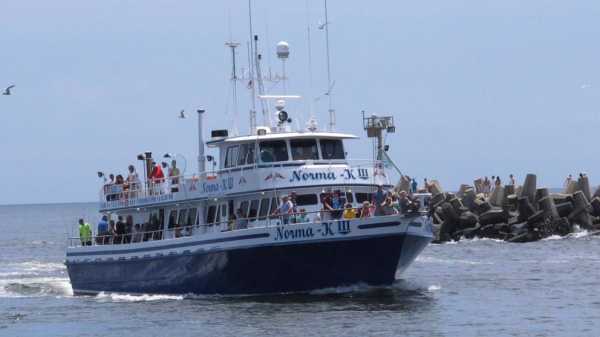
ATLANTIC CITY, N.J. — A joint study by two federal government scientific agencies and the commercial fishing industry documents numerous impacts that offshore wind power projects have on fish and marine mammals, including noise, vibration, electromagnetic fields and heat transfer that could alter the marine environment.
It comes as the offshore wind industry is poised to grow rapidly on the U.S. East Coast, where it is facing growing opposition from those who blame it for killing whales — something numerous scientific agencies say is not true.
The National Oceanic and Atmospheric Administration, the Bureau of Ocean Energy Management and the Responsible Offshore Development Alliance issued their report Wednesday after a 2 1/2-year-long study of the impacts existing offshore wind projects have on fish and marine mammals.
The goal was to solidify existing knowledge of the impacts and call for further research in many areas.
NOAA and BOEM are among agencies that say there is no link between offshore wind preparation and whale deaths. Their co-authorship of a report detailing potential negative impacts on fish and marine mammals may intensify an already highly politicized controversy.
Asked Friday about the likelihood of this happening, NOAA spokesperson Lauren Gaches reiterated the agency's position that offshore wind is not causing the whale deaths, which remain under investigation.
“We will also continue to explore how sound, vessel, and other human activities in the marine environment impact whales and other marine mammals,” she said.
The fishing industry is concerned that fish near construction sites may be killed or chased away for prolonged periods even after the turbines are built, according to the report.
“Physical changes associated with (offshore wind) developments will affect the marine environment — and, subsequently, the species that live there — to varying degrees,” the report read. ”These include construction and operation noise and vibration, electromagnetic fields, and thermal radiation from cables, as well as secondary gear entanglement.
In an interview, Fiona Hogan, research director for the Responsible Offshore Development Alliance, said: "We wanted to document what was known and not known. As far as we know, this is the first cooperatively developed report that cites all aspects of the potential interactions between fisheries and offshore wind.”
The alliance is a fishing industry group trying to improve the compatibility of offshore wind with fishing operations.
The American Clean Power Association, an offshore wind industry group, said Friday it was still studying the 388-page report.
Andy Lipsky, who oversees the wind energy team at NOAA's Northeast Fisheries Science Center, is a co-author of the report. He said it helps the agencies define the type of monitoring required for long-term study of offshore wind's effects and points out "needed research on how offshore wind energy changes marine habitats and fisheries.”
Several concerns raised in the report mirror many of those raised by opponents of offshore wind, including those who blame preparation for offshore wind farms for killing whales along the East Coast. Since December, 30 whales have washed ashore there.
The report said offshore wind turbines can attract fish and marine life, but also repel them. The large underwater platforms are rapidly colonized by smaller marine life which in turn attracts larger predators to the area. Water cloudiness from turbine operations, noise, vibrations and electromagnetic fields could also make them leave the area.
Hogan said some disagreement remains on whether wind platforms will be a net attraction or deterrent to fish.
Regarding noise, the report said sounds emitted from pile-driving during construction “can be severe, resulting in mortality or injury of hearing tissues.” Noise levels from ongoing operation of the turbines once constructed “are not associated with direct physical injury, (but) long-term exposures may have negative effects on communication, foraging, and predator detection.”
In almost every instance, the report called for additional research. The study only dealt with fixed-location wind turbines; a second study will examine wind projects that float on the water's surface.
The $150,000 survey was funded by NOAA.
___
Follow Wayne Parry on Twitter at www.twitter.com/WayneParryAC
Sourse: abcnews.go.com






